Table of Contents
What Is Artificial Insemination in Dogs?
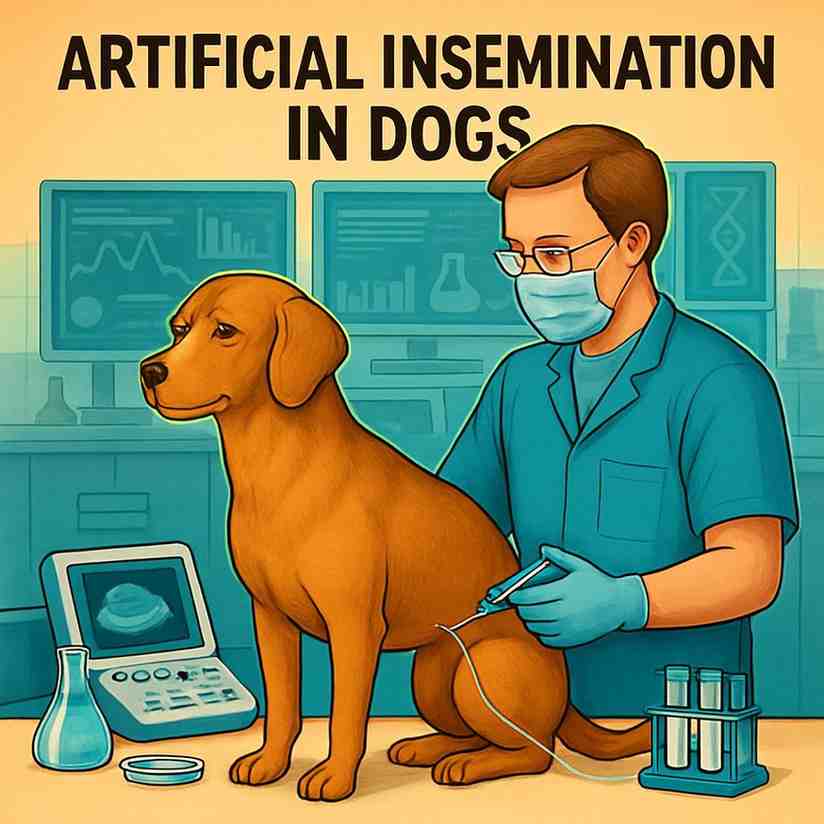
Artificial insemination in dogs involves collecting semen from a male dog (the stud) and manually placing it into the reproductive tract of a female dog (the bitch) to achieve pregnancy without natural mating. This technique, first successfully performed in 1784 by Italian scientist Lazzaro Spallanzani, has evolved significantly, thanks to advancements in veterinary science and reproductive technology. Today, AI is a valuable tool for dog breeders worldwide, used to enhance genetic diversity, overcome geographical barriers, and address health or behavioral issues that prevent natural breeding.
AI isn’t just a high-tech trick—it’s a practical solution for many scenarios. For example, it allows a breeder in the United States to use semen from a champion stud in Europe without flying the dog across the ocean. It’s also a lifeline for dogs with physical limitations, like a male with arthritis who can’t mate naturally or a female with anatomical issues.
Why Choose Artificial Insemination In Dogs?
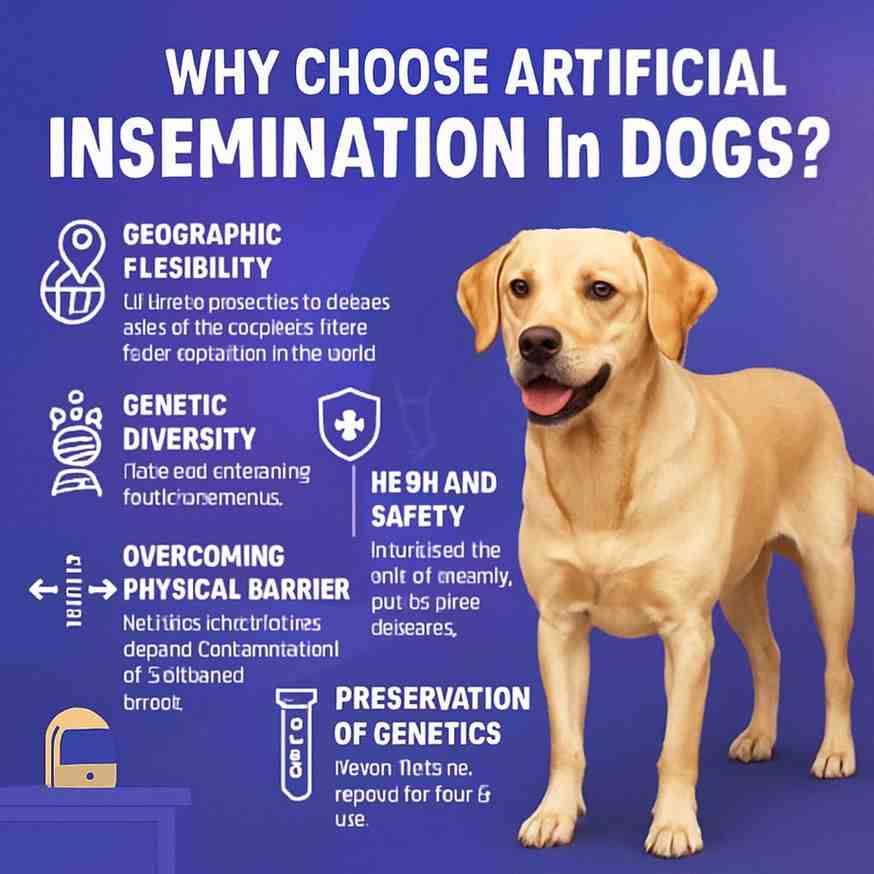
Why go through the hassle of AI when natural mating has worked for centuries? Here are some compelling reasons breeders and pet owners opt for this method:
- Geographic Flexibility: Artificial insemination in dogs lets breeders access top-quality genetics from dogs located anywhere in the world. Frozen semen can be shipped globally, saving the stress and cost of transporting live animals.
- Genetic Diversity: By using semen from distant or deceased dogs, breeders can introduce new genes into a population, reducing inbreeding and strengthening the breed.
- Health and Safety: Artificial insemination in dogs minimizes the risk of sexually transmitted diseases, like Brucella canis, by avoiding direct contact between dogs.
- Overcoming Physical Barriers: Dogs that can’t mate naturally due to conformational issues, injuries, or behavioral problems (like aggression or shyness) can still reproduce through AI.
- Preservation of Genetics: Semen from valuable stud dogs can be frozen and stored for years, allowing their legacy to continue even after they pass away.
However, Artificial insemination in dogs isn’t without its challenges. It requires skilled professionals, precise timing, and sometimes costly equipment. There are also ethical concerns, like ensuring the procedure prioritizes animal welfare and doesn’t perpetuate harmful traits.
How Does Artificial Insemination Work in Dogs?
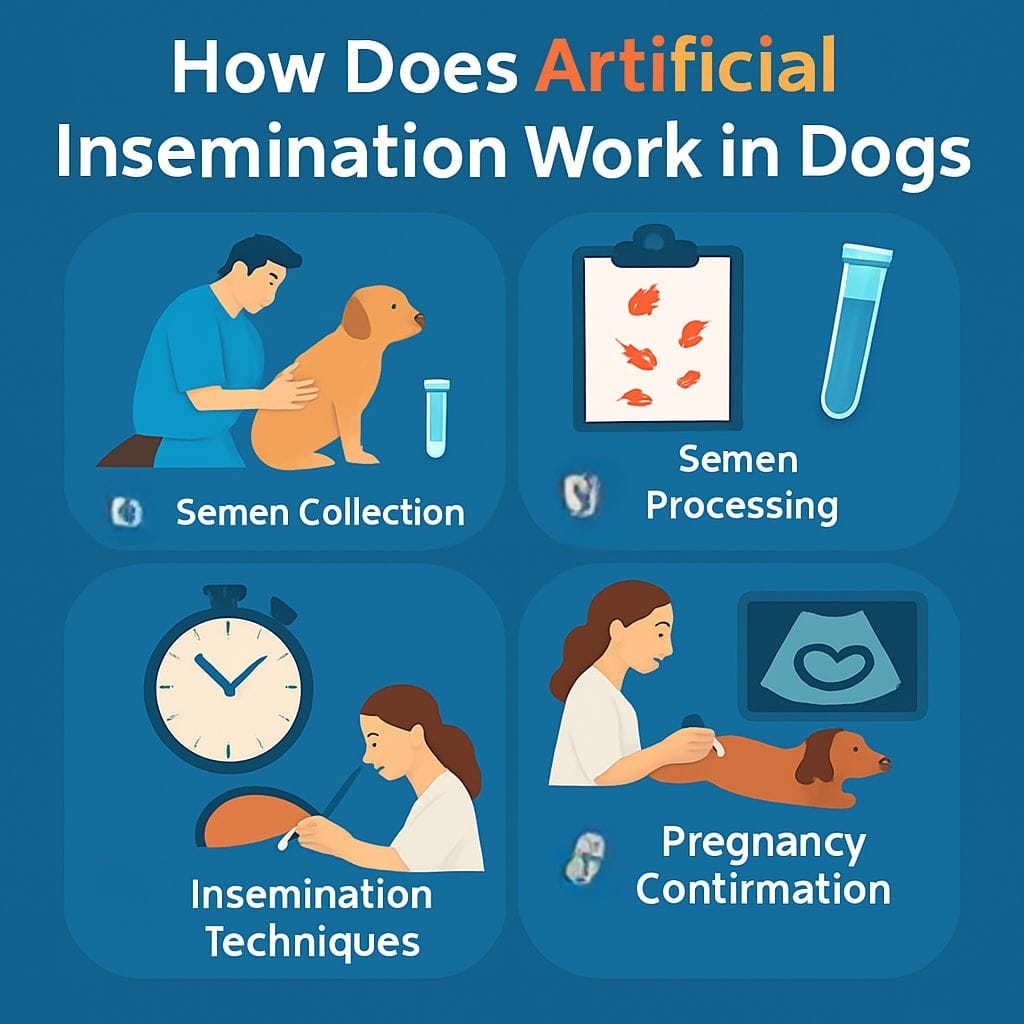
The Artificial insemination in dogs process is a blend of science, timing, and skill. Let’s break it down into simple steps:
Step 1: Semen Collection
Semen is collected from the stud dog, usually through manual stimulation in a calm, quiet environment. A trained professional ensures the process is stress-free for the dog. In some cases, a female in heat (or her scent) is used to encourage ejaculation. The collected semen is then evaluated for quality—factors like sperm count, motility (how well the sperm move), and morphology (sperm shape) are critical to success.
Step 2: Semen Processing
Once collected, semen can be used in three forms:
- Fresh Semen: Used immediately, typically when the stud and bitch are nearby. Fresh semen has the highest viability, lasting up to 5–7 days in the female’s reproductive tract.
- Fresh-Chilled Semen: Diluted with extenders (like egg yolk or buffers) and cooled to 4°C, this semen can be shipped and remains viable for 3–4 days.
- Frozen Semen: Stored in liquid nitrogen at -196°C, frozen semen can last indefinitely but has a shorter lifespan (12–24 hours) in the female’s reproductive tract after thawing.
Each type has its pros and cons, as shown in the table below:
| Semen Type | Viability in Female | Storage Duration | Best Use Case |
|---|---|---|---|
| Fresh Semen | 5–7 days | Immediate use | Local breeding |
| Fresh-Chilled | 3–4 days | Up to 10 days | National/International shipping |
| Frozen Semen | 12–24 hours | Indefinite | Long-term storage or deceased studs |
Step 3: Timing the Insemination
Timing is everything in process of artificial insemination in dogs . The bitch must be inseminated during her fertile window, which occurs around ovulation. Vets use tools like vaginal cytology (examining vaginal cells under a microscope), vaginoscopy (visual inspection of the vagina), and progesterone testing to pinpoint the optimal time. Progesterone levels rise during the estrus cycle, signaling when ovulation is near. Frozen semen, with its shorter lifespan, requires especially precise timing.
Step 4: Insemination Techniques
There are three main methods for depositing semen in the bitch:
- Vaginal Insemination: Semen is placed in the vagina using a catheter. This method is simple and non-invasive but less effective for frozen semen due to lower sperm survival rates.
- Transcervical Insemination (TCI): A catheter is guided through the cervix into the uterus using an endoscope or palpation. TCI is highly effective, especially for frozen semen, and doesn’t require anesthesia.
- Surgical Insemination: Semen is injected directly into the uterus via a surgical incision under general anesthesia. While effective, this method is controversial due to welfare concerns and is banned in countries like Norway, Sweden, and the UK.
Step 5: Pregnancy Confirmation
About 25–30 days after insemination, a veterinarian can confirm pregnancy using ultrasound. Success rates vary depending on the semen type and insemination method, with intrauterine methods (TCI or surgical) typically yielding higher pregnancy rates (up to 84% for frozen semen with TCI) compared to vaginal insemination (around 58%).
Real-World Example: A Case Study
Let’s look at a practical example to see artificial insemination in dogs in action. In 2005, three Mexican gray wolf females in a conservation program were artificially inseminated using fresh semen from unrelated males. All three females successfully whelped, demonstrating AI’s potential in preserving endangered species. The procedure used intrauterine insemination, and careful monitoring ensured the semen was deposited at the optimal time. This case highlights how AI can support genetic diversity in small, captive populations, like the endangered Mexican gray wolf, where natural mating opportunities are limited.
Scientific Insights into Artificial Insemination In Dogs Success
The success of AI depends on several scientific factors:
- Semen Quality: Sperm motility and morphology are critical. Studies show that semen with at least 70% motile sperm and normal morphology has the best chance of fertilization.
- Timing: Ovulation in dogs occurs 1–3 days after the luteinizing hormone (LH) surge. Progesterone testing is more reliable than LH testing due to the short duration of the LH surge.
- Insemination Site: Intrauterine deposition (via TCI or surgical AI) significantly boosts pregnancy rates compared to vaginal deposition, especially for frozen semen. A 1999 study by Linde-Forsberg found an 84.4% whelping rate with intrauterine AI versus 58.9% for vaginal AI using frozen semen.
- Semen Preservation: Freezing semen reduces sperm viability, so extenders with egg yolk or other protectants are used to minimize damage. Research continues to improve cryopreservation techniques for better outcomes.
Success Rates Of Artificial Insemination In Dogs

This chart shows that transcervical insemination (TCI) has the highest whelping rate at 84.4%, followed by surgical AI at 80%, and vaginal AI at 58.9%.
Benefits and Challenges of AI in Dogs
Benefits of Artificial Insemination in Dogs
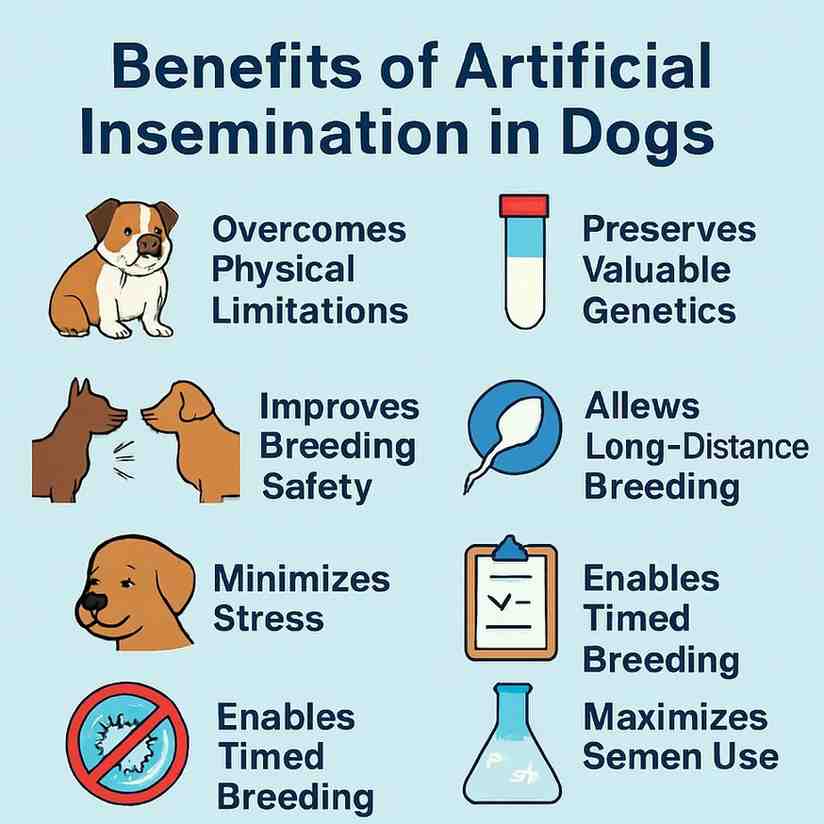
- Overcomes Physical Limitations
- Helps breeds with anatomical challenges (like Bulldogs, Pugs) that cannot mate naturally due to body structure.
- Improves Breeding Safety
- Reduces the risk of injury to both male and female during mating, especially in aggressive or inexperienced dogs.
- Preserves Valuable Genetics
- Enables the use of semen from top-quality studs around the world without transporting the dog.
- Allows Long-Distance Breeding
- Frozen or chilled semen can be shipped internationally, making rare and desired genetics accessible.
- Minimizes Stress
- Less stressful for nervous, aggressive, or inexperienced dogs compared to natural mating.
- Prevents Disease Transmission
- Reduces the risk of sexually transmitted infections and parasites between breeding partners.
- Enables Timed Breeding
- Artificial insemination in dogs can be timed perfectly with ovulation (using progesterone testing) to maximize the chances of pregnancy.
- Maximizes Semen Use
- Even low sperm counts or small semen volumes from valuable studs can be utilized efficiently.
- Supports Older or Injured Dogs
- Allows older males or those with mobility issues to still contribute genetically.
- Conservation of Rare Breeds
- Helps preserve endangered breeds and maintain genetic diversity.
- Storage for Future Use
- Semen can be frozen and stored for years, ensuring future breeding opportunities even after the stud is no longer alive.
Challenges of Artificial Insemination in Dogs
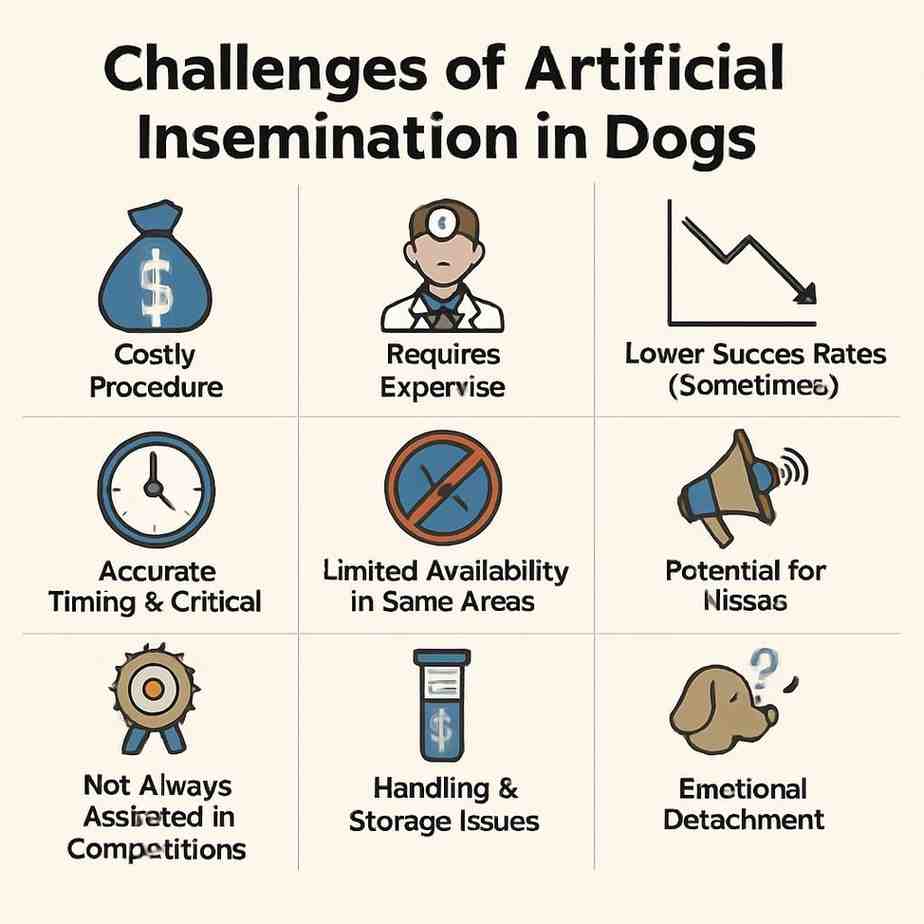
- Costly Procedure
- AI, especially with frozen semen and advanced techniques, can be expensive compared to natural mating.
- Requires Expertise
- Must be performed by a skilled veterinarian or trained professional to avoid injury and ensure success.
- Lower Success Rates (Sometimes)
- If timing or technique is poor, the chances of pregnancy can be lower than natural mating.
- Accurate Timing is Critical
- Requires precise ovulation testing (e.g., progesterone testing) to increase chances of conception.
- Limited Availability in Some Areas
- Not all veterinary clinics offer AI services, especially in rural or underdeveloped areas.
- Potential for Misuse
- Unethical use (e.g., overbreeding, breeding unhealthy dogs) can happen without proper regulations.
- Not Always Accepted in Competitions
- Some kennel clubs or breed registries have restrictions on registering puppies conceived through AI.
- Handling & Storage Issues
- Frozen semen must be properly stored and shipped, which can be logistically challenging.
- May Not Address Fertility Issues
- If either dog has underlying reproductive problems, AI won’t solve them unless diagnosed and treated first.
- Emotional Detachment
- Some breeders feel it lacks the natural bond and instinctive behaviors seen in natural mating.
🐾 Ethical Considerations in Dog Breeding & AI
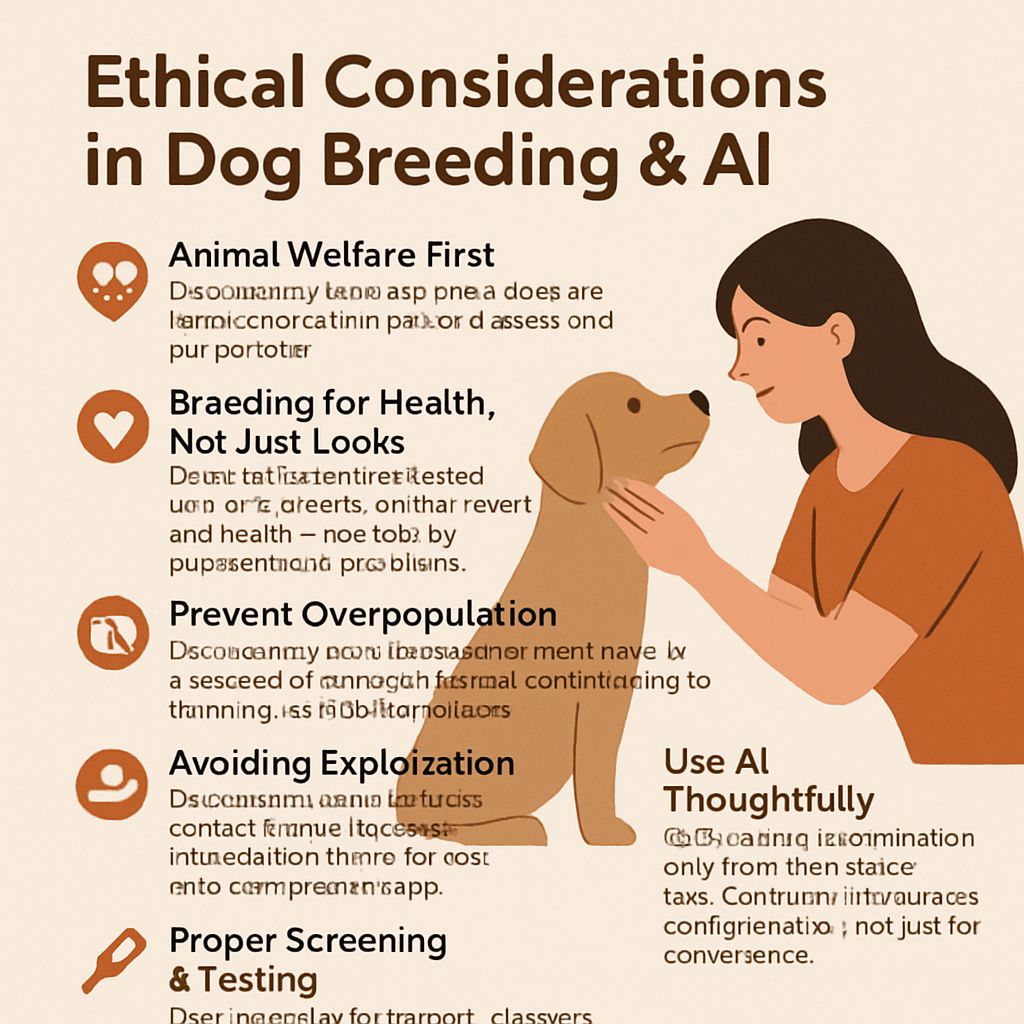
- Animal Welfare First
- Ensure both male and female dogs are healthy, free from pain or distress, and not overbred.
- Avoid forcing dogs with serious health issues or structural problems to reproduce.
- Breeding for Health, Not Just Looks
- Select breeding pairs based on good genetics, temperament, and health — not only on appearance or popularity of the breed.
- Prevent Overpopulation
- Be responsible and breed only when there is a demand for puppies, to avoid contributing to stray and shelter dog problems.
- Avoiding Exploitation
- Do not treat dogs merely as money-making machines — respect their needs for rest, care, and companionship.
- Proper Screening & Testing
- Test both dogs for genetic diseases and infections (e.g., brucellosis) before breeding.
- Transparency With Buyers
- Provide full and honest information about the puppy’s health, vaccinations, and any known hereditary conditions.
- Respect Breed Standards Responsibly
- Don’t breed dogs to extreme traits (like overly flat faces or very short legs) that compromise their quality of life.
- Use AI Thoughtfully
- Use artificial insemination only when necessary (e.g., anatomical issues, preserving rare genetics), not just for convenience.
- Regulations & Guidelines
- Follow local animal welfare laws and kennel club guidelines regarding breeding and the use of AI.
- Commitment to the Puppies
- Ensure that all puppies find good homes and do not end up abandoned or in shelters.
🦠 Diseases Transmitted by Natural Mating in Dogs
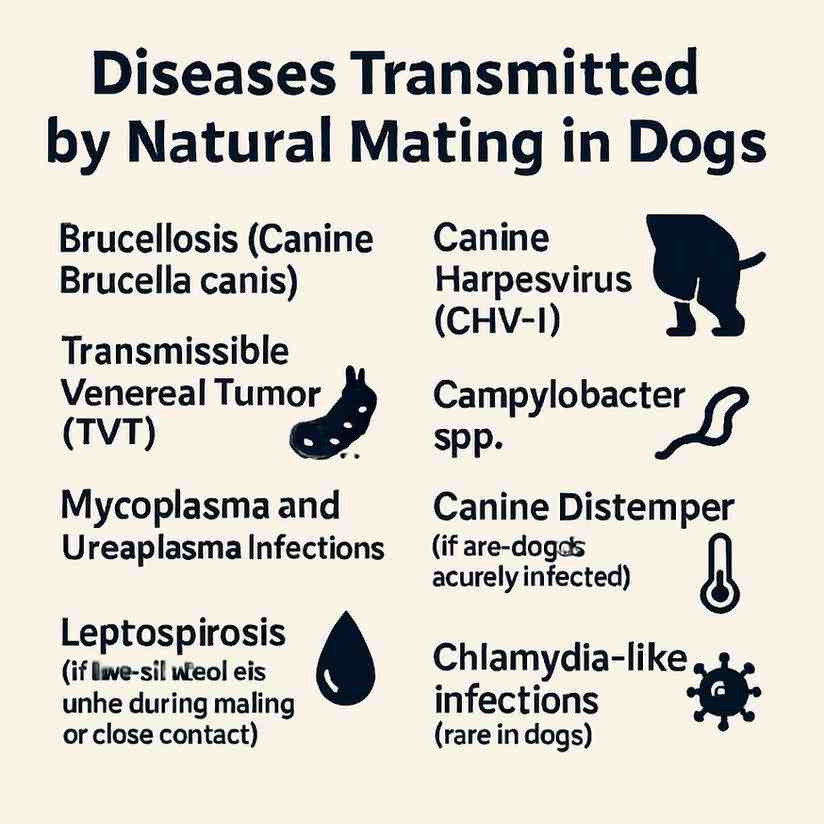
- Brucellosis (Canine Brucella canis)
- A bacterial infection causing infertility, abortions, stillbirths, and orchitis in males.
- Highly contagious during mating.
- Canine Herpesvirus (CHV-1)
- A viral infection that can cause abortions, stillbirths, or fading puppy syndrome.
- Transmissible Venereal Tumor (TVT)
- A contagious cancer that spreads during mating, appearing as growths on the genitalia.
- Mycoplasma and Ureaplasma infections
- Bacterial infections that may lead to infertility, vaginal discharge, and poor pregnancy outcomes.
- Campylobacter spp.
- Less common, but may cause reproductive tract infections and abortion.
- Canine Distemper (if one dog is acutely infected)
- Rare via mating but possible if close contact occurs with body fluids.
- Leptospirosis (if transmitted via urine during mating or close contact)
- Rare through direct mating, but theoretically possible.
- Chlamydia-like infections (rare in dogs)
- Can contribute to reproductive issues, though much less studied in canines compared to other species.
✅ This is why health screening of both the male and female before breeding is critical — especially testing for Brucella canis and checking for any signs of infections or tumors.
Tips for Breeders Considering Artificial Insemination In Dogs
If you’re thinking about using AI for your dog, here are some practical tips:
- Choose a Qualified Professional: Work with a veterinarian experienced in canine reproduction. They should be skilled in semen collection, evaluation, and insemination techniques.
- Test Both Dogs: Ensure the stud and bitch are healthy and free of genetic or infectious diseases, like Brucella canis, before proceeding.
- Monitor the Bitch’s Cycle: Use progesterone testing and vaginal cytology to time the insemination accurately.
- Understand the Costs: AI can range from $200 to $1,000 or more, depending on the method, semen type, and veterinary fees.
- Follow Regulations: In some countries, like the UK, AI must be performed by a veterinarian, and litters must be registered with the appropriate kennel club.
Countries and Common Breeds for AI

| Rank | Country | Common Breeds | Why AI Is Used |
|---|---|---|---|
| 1 | United States | French Bulldog, Bulldog, German Shepherd, Dachshund | Large breeding industry, geographic flexibility, champion genetics |
| 2 | United Kingdom | Pug, English Bulldog, Cavalier King Charles Spaniel | Pedigree culture, genetic diversity, banned surgical AI |
| 3 | Australia | French Bulldog, Australian Cattle Dog, Greyhound | Isolated geography, TCI adoption, welfare concerns |
| 4 | Sweden | Swedish Vallhund, Norwegian Elkhound, Dachshund | Research leadership, banned surgical AI, TCI focus |
| 5 | Netherlands | Dutch Shepherd, Bulldog, Greyhound | Semen export, conservation, pedigree breeding |
| 6 | New Zealand | New Zealand Huntaway, French Bulldog, Labrador Retriever | Isolation, working dog genetics, TCI reliability |
| 7 | Japan | Shiba Inu, French Bulldog, Pug | Pet culture, conformational challenges, imports |
Why These Breeds?
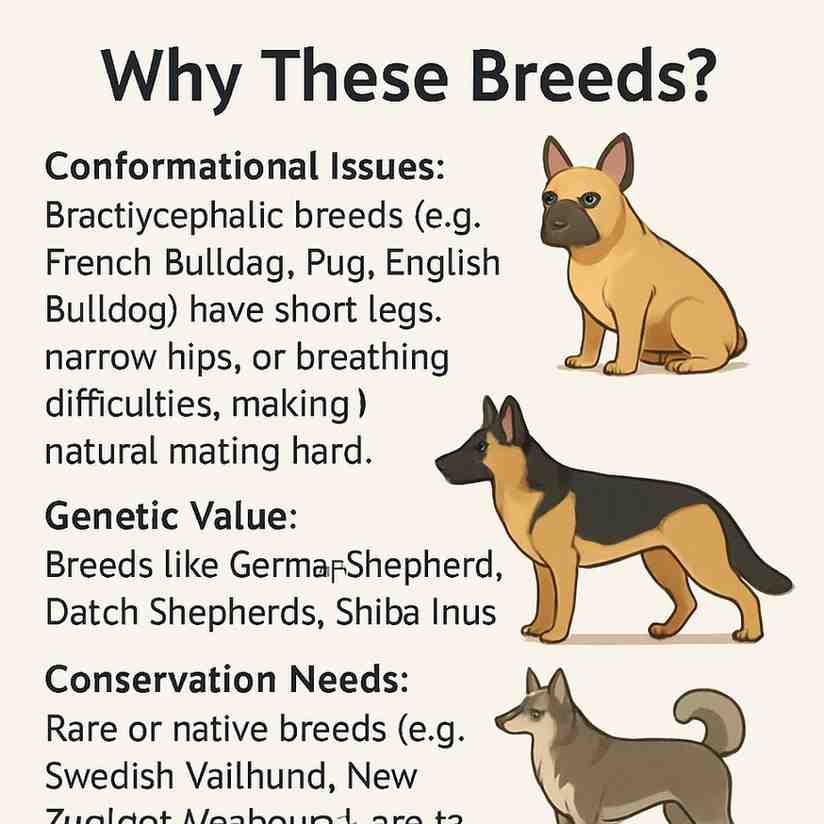
AI is often used for breeds with:
- Conformational Issues: Brachycephalic breeds (e.g., French Bulldog, Pug, English Bulldog) have short legs, narrow hips, or breathing difficulties, making natural mating hard.
- Genetic Value: Breeds like German Shepherds, Dutch Shepherds, or Shiba Inus are prized for working or show traits, so AI preserves top bloodlines.
- Conservation Needs: Rare or native breeds (e.g., Swedish Vallhund, New Zealand Huntaway) use AI to maintain genetic diversity.
- Welfare Regulations: In countries like the UK and Sweden, AI is used ethically to avoid breeding dogs with severe health issues, though concerns remain about perpetuating conformational problems.
Conclusion
Artificial insemination in dogs is a powerful tool that blends science and passion for canine health and genetics. It offers breeders the chance to create healthier, more diverse litters while overcoming challenges like distance, physical limitations, or the loss of a valuable stud. From the first successful AI in 1784 to modern techniques like transcervical insemination, this method has transformed dog breeding and conservation efforts. However, it’s not a one-size-fits-all solution—success requires expertise, ethical consideration, and a commitment to animal welfare.
Whether you’re a breeder aiming to improve your kennel’s genetics or a pet owner curious about reproductive technology, artificial insemination in dogs opens up exciting possibilities. By understanding the process, benefits, and challenges, you can make informed decisions that prioritize the health and happiness of your dogs. If you’re ready to explore AI, consult a trusted veterinarian and take the first step toward a new era of responsible breeding.
FAQs About Artificial Insemination in Dogs
What is artificial insemination in dogs?
Artificial insemination (AI) involves collecting semen from a male dog and manually placing it in a female’s reproductive tract to achieve pregnancy. It’s used to overcome mating barriers, preserve genetics, or access distant studs. Consult a vet for best results.
How many times can I inseminate my dog?
A dog can typically be inseminated 1–3 times per heat cycle, with 2 being common for fresh/chilled semen and 1–2 for frozen, based on ovulation timing. Lifetime limits are 4–6 litters, depending on health. Consult a vet for precise timing.
What is the best day to get artificial insemination for my dog?
The best day for canine AI is 2–4 days after ovulation, around days 9–14 of the heat cycle, determined by progesterone testing. A vet can pinpoint the fertile window for maximum success. Timing is critical, especially for frozen semen.
What are the risks of artificial insemination in dogs?
Canine AI risks include infection, stress, or lower success rates (e.g., 58.9% for vaginal AI). Surgical AI carries anesthesia risks, and AI may perpetuate genetic issues if not done ethically. Work with a skilled vet to minimize complications.
Which type of artificial insemination is best for dogs?
Transcervical insemination (TCI) is often best, with an 84.4% whelping rate, no anesthesia, and effectiveness for all semen types. It balances success and welfare compared to vaginal or surgical AI. Consult a vet for your dog’s needs.
How many days after AI does a dog get pregnant?
Pregnancy begins 1–3 days after successful AI, when sperm fertilizes eggs during the fertile window. Ultrasound confirms pregnancy around 25–30 days post-AI. A vet can monitor for accurate results.
Can I buy dog sperm for artificial insemination?
Yes, you can buy chilled or frozen dog sperm from reputable semen banks like the International Canine Semen Bank. Health screenings and AKC compliance are required. Consult a vet for proper handling and insemination.
How much does artificial insemination cost for dogs?
Canine AI costs $200–$1,000 per attempt, depending on the method (vaginal, TCI, or surgical) and semen type (fresh, chilled, or frozen). Additional costs include progesterone testing and vet fees. Check with local clinics for pricing.
Which dog breeds commonly use artificial insemination?
Breeds like French Bulldogs, English Bulldogs, Pugs, and German Shepherds often use AI due to conformational issues or to preserve valuable genetics. AI is also used for rare breeds like the Swedish Vallhund. Ethical breeding is key.
Is artificial insemination safe for my dog?
AI is generally safe when performed by a skilled vet, with TCI being the least invasive. Risks like infection or stress are low with proper technique and health screenings. Always prioritize your dog’s welfare and consult a professional.
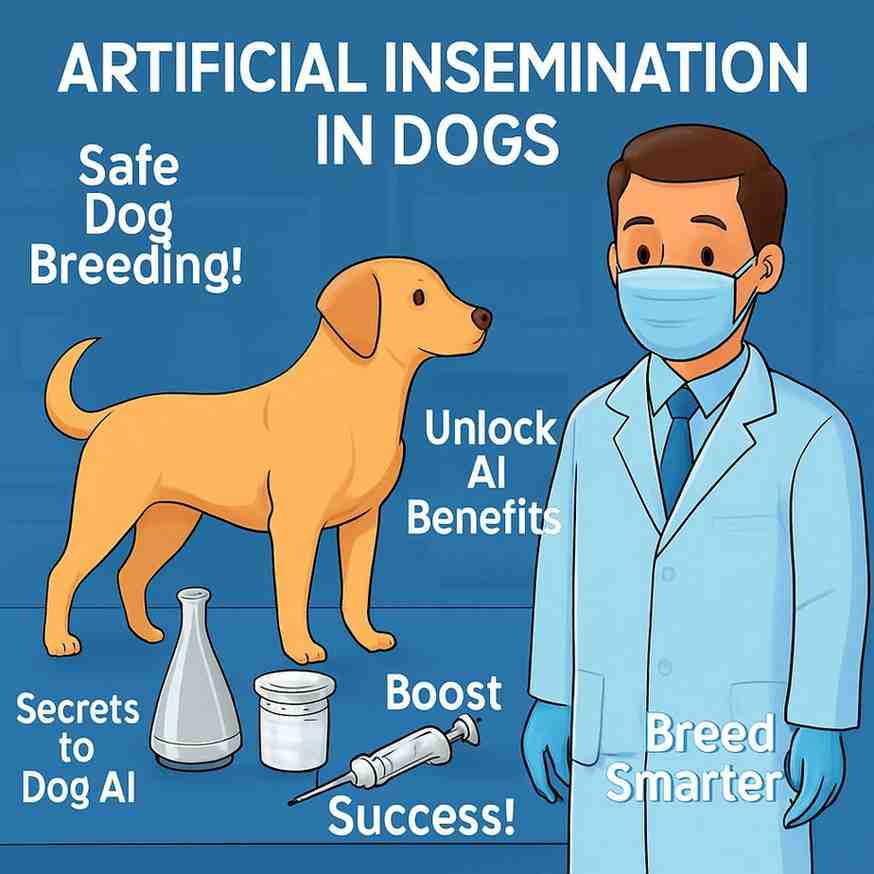
This really answered my downside, thank you!
Hey would you mind letting me know which web host you’re working with? I’ve loaded your blog in 3 different internet browsers and I must say this blog loads a lot quicker then most. Can you suggest a good internet hosting provider at a fair price? Kudos, I appreciate it!